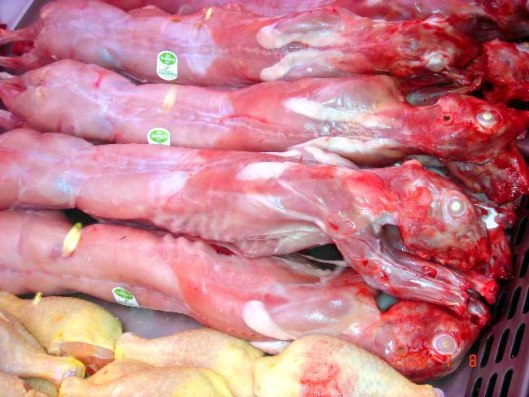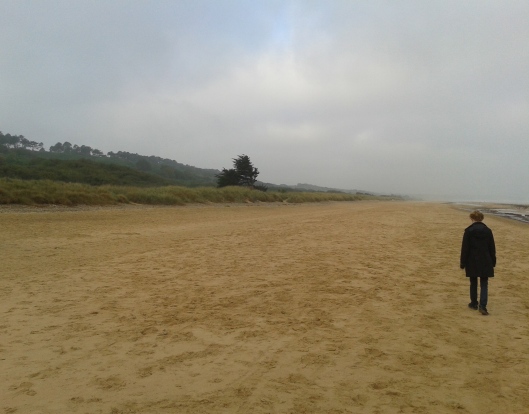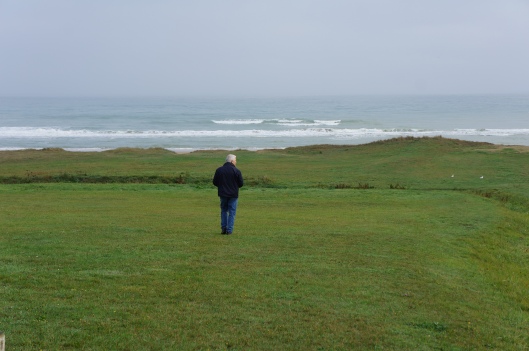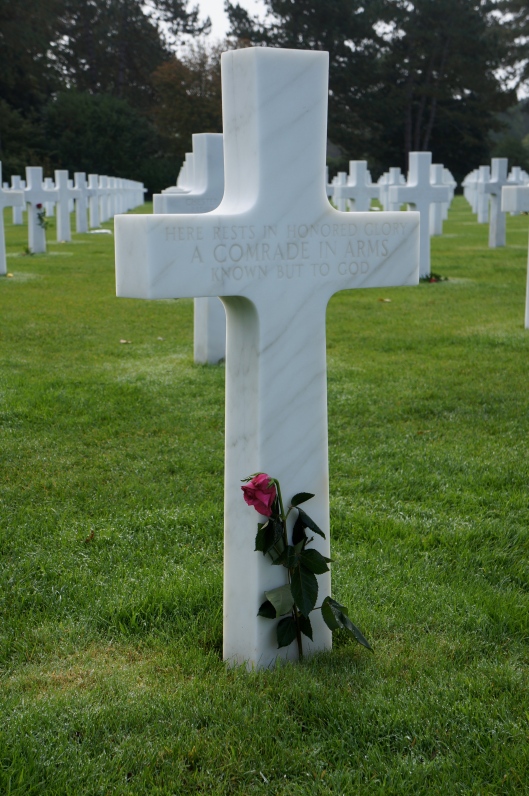So, week 5 ends and I’m halfway completed with the first semester of Basic Cuisine. As I noted last week, things are in a real rhythm now. No longer are we more concerned about forgetting part of our uniform, or missing a knife, or being late, etc. We can now actually start thinking about the basics of cooking like a professional. It’s definitely getting more fun and more rewarding. But the work level remains just as high if not higher.
The week consisted of 3 lessons. The first was a Rabbit in Mustard sauce. This particular dish is one of the classics of the school and is most certainly going to be one of the exam dishes.
We started with a whole skinned rabbit and were required to properly butcher it. This included, chopping off the head, removing the hind and front legs, separating the breast from the loin, removing and trimming the liver and kidneys, and then segmenting the loin into 3 pieces. This was pretty straightforward. I actually found it easier than filleting a fish. The rabbit was supposed to have been already bled, but when I chopped his head off, he bled all over my workspace.
We then browned the rabbit, coated it in a really nice dijon mustard, cooked it in the oven with stock and then reduced the juices into a thick mustard sauce, which was incredible with the meat. We skewered the liver and kidneys on a sprig of rosemary, seasoned and sautee’d those in butter. We finished the dish by cutting potatoes croquette and slicing them into little discs. We then sautee’d the potatoes in butter, lightly salted and added crushed garlic and finely chopped parsley. I really had no problem with the dish. The chef marked me down slightly because there was a smudge on my plate and also part of presentation actually touched the outer rim of the serving plate, which I now know is strictly reserved for handling the plate.
Second this week was poached hake steaks (a round white fish). This was accompanied with turned zucchini, turned potatoes and the “piece de resistance,” the dreaded Hollandaise Sauce! Turning vegetables is a trick we need to master. The hake was straightforward. We made a court-boullion, which is an aromatic broth, and poached the hake steaks in that. We turned the zucchini and potatoes and cooked them. I think potatoes and zucchini were both in the lesson because it illustrated and contrasted the different techniques for cooking each.
Green vegetables such as zucchini or green beans are always put into boiling salted water and then shocked in an ice bath when done cooking and left to dry. Potatoes are always put in cold salted water and set to boil. When cooked, you pour out half of the hot water in the pan and replace with cold water in order to not “shock” the potatoes.
The real test of this lesson was to make a Hollandaise sauce. It’s not that hard, but if you make a subtle error, you get a separated mess from which you must start over. Basically you mix some egg yolks with cold water. You then whisk over a bane-marie (double boiler) until the eggs and water reach what is called the ribbon stage. If you let the heat get too hot, you get some nice scrambled eggs. If you let it get too cold you don’t get an emulsification. There is about a 10-15 degree temperature range, just below boiling that you have to work in. Once this is done you whisk in heated clarified butter, again not too hot or cold. If all goes well, you have this amazing fluffy creamy yellow sauce that you can season with lemon juice, salt and cayenne pepper.
My sauce turned out very good. I have never had “real” Hollandaise before. This stuff was the “real deal.” Incredible. Hollandaise, or the same technique is also the basis for “Bearnaise” sauce which we will do with beef in the next couple of weeks.
Upon presentation, the chef was pleased with everything I had done, except he criticized the seasoning of my potatoes, which was just a touch of salt. And I thought, this is getting interesting if they are now pushing us on tiny increments of seasonings. I just love the attention to detail and the respect for quality and perfection that these chef’s have!
The third lesson this week was a braised sea brill, with turned potatoes. This is also a dish that very likely may be on the exam. We had to fillet a brill, which is a flatfish like the lemon sole and braise it in a fish stock (fume poisson) that we made from the carcass. We then had to turn and cook potatoes and also make a sauce by reducing the remaining cooking liquid to a glaze and finishing it with butter. What I found interesting here is that the recipe was a littler simpler I believe because it gave us time to focus on getting the seasoning and thickness of the sauce right. We weren’t running around like crazy people trying to do a million tasks.
When I presented mine to the chef, he first noted that my plate was too hot! For the potatoes, this time before serving I decided to roll them in butter and season them well, however he remarked that they were slightly undercooked, which they were. Everything else including the presentation, doneness of the fish, flavor of the fish, texture and flavor of the sauce was “Tres Bien.”
Another highlight of the week is 10 of us took a walking tour of a Paris market with one of the chefs. Paris is known for its open air neighborhood markets where you can find the best of everything. Paris residents don’t really buy groceries in supermarkets. They go to the specialty shops in the markets. The chef took us through a number of stalls or shops in the market and explained where the food came from, what was in season and how to tell what is good. He also bought all kinds of breads, cheeses, charcuterie, etc., from the different vendors and we went back to school, sat down and had a feast!
Whisper a Prayer for the Boys
On a slightly more serious note. Last week, we were fortunate to have some friends from Las Vegas come for a visit, so on the weekend we rented a car and drove to Normandy. We visited the famous (and quite beautiful) Mont St. Michel on Saturday and stayed at a small hotel in the little fishing village of Bayeux. On Sunday we went to Omaha Beach, the site of the allied invasion of Normandy for the liberation of Europe.
I have always wanted to visit Omaha beach, but I have to confess, I wasn’t prepared for what I found. Standing on the surprisingly small beach below the 15-20 foot bluff, you can vividly see and hear those young boys, so scared but so brave, land on the beach and rush the short 30-40 yards up to the bluff just above. They knew that for many of them it would be a rush to their death with the Germans so entrenched above them. But they charged on and they didn’t give up and thankfully, they prevailed.
Walking around, I couldn’t help but reflect that perhaps every young American man and woman should walk that beach and those bluffs. They should learn about what happened there and why. And most importantly, they should fully understand the sacrifice and exactly what the courage, the freedom, the liberty and the capitalistic prosperity of our country gave back to the world on that day.
This was not a time for self absorbed rhetoric or phony political arguments about so-called “fairness.” This was a time when young Americans placed honor and duty before and above any self interest. They didn’t make their ultimate sacrifice out of a blind patriotism, they did it out of a clear vision of what was right and what was wrong.
God Bless the Greatest Generation













I look forward to your post every week, but I must say that the rabbit about “did me in.” I’ve been known to cry when shrimp arrives at the table with the head on. My philosophy is never to eat anything I’ve met personally. I think I will stick with teaching for the time being…
On another note, my son and daughter-in-law are going to Paris on Wednesday to celebrate his fortieth birthday (!), and I would love to give them recommendations for excellent meals. Cost is not an issue. Any ideas from an expert?
Hi Joan, good to hear from you and thanks so much for the comment! I was fine with the rabbit. At least I was until bright red blood started spurting out his neck as i cut his head off. But I survived. (I can’t say the same for “Monsieur le Bunny!”). Speaking of shrimp. We get to behead and fry some of them this afternoon.
Hope you and Peter are doing great. As for restaurants, Susan is going to send you another note separately. My gosh, there are so many here, we hardly feel qualified to make suggestions, but we have heard of a few, and there are some good online resources we can refer you to with lots of information and suggestions.
take care,
john & susan
I work with your brother Walt and am enjoying your big adventure. I always take pictures of my food when I travel so I am so loving your pictures of your lessons:)
You make retirement look very appealing!!